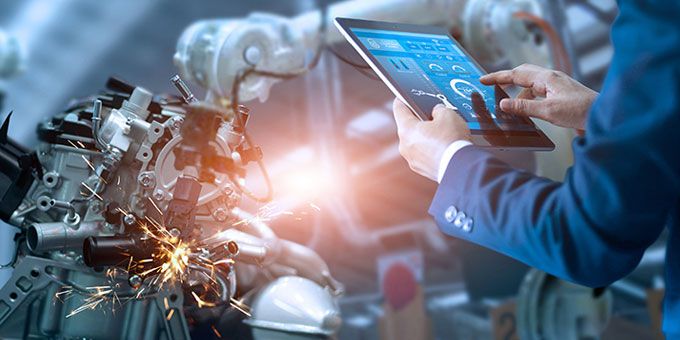As it is clear that industrial robotics would continue to transform every sector in several ways, here are some of the prominent trends that would play a vital role in the coming years.
 6 Disrupting Trends in Industrial Robotics Poised To Transform Manufacturing
6 Disrupting Trends in Industrial Robotics Poised To Transform Manufacturing

Research from | Allied Analytics LLP
Robotic automation is rapidly evolving and has revolutionized the manufacturing and industrial world. Over the last few years, industrial robots have become smarter and started to make a move into the wider world of business.
Robotic workers are now commonplace in automobile and manufacturing and are expected to gain popularity for their profitability and productivity. According to Allied Market Research, the global industrial robotics market is projected to garner $70.72 billion by 2023, registering a CAGR of 9.4% from 2017 to 2023. High demand for automation, increased labor cost and a dearth of the skilled workforce coupled with evolving robotics and artificial intelligence (AI) industry would be the major driving factors for the growth of the industrial robotics industry. As it is clear that industrial robotics would continue to transform every sector in several ways, here are some of the prominent trends that would play a vital role in the coming years.
Adoption of AI
For years, people have invested a huge pile of money in sensor and data technology. This is the time where those investments and advancements in advanced analytics and AI would come together. For instance, after years of research and trials, people now can see driverless cars on the roads. AI can be applied to cars, drones, boats, and other vehicles including warehouse robotics. Soon, robots would become a major source of information on the factory floor. As robotic automation is gaining widespread adoption, the need for open automation architecture would increase. Industry players would collaborate with each other to create open documentation to make robotic integration easier and improve their compatibility.
China would continue to dominate
The growth of the robotic industry is dependent on its adoption rate and growth of startups that are investing capital in the market. China has been buying more industrial robots every year than any other country since 2013. According to Marketing Intelligence Resource, a Beijing-based research firm, the country’s investment in smart manufacturing in 2018 increased 46% on the year to 69.6 billion yuan or $10.1 billion. China’s decade long economic ascent as “Workshop of the World” is now spending big bucks to swap workers for high-tech robots. This push in industrial robotics is a part of the government’s ambitious plan called “Made in China 2025” to make China a self-sufficient high-tech superpower. To do so, robotics is a high priority as it is vital to keep the country’s industrial competitors at bay.
Advent of new companies
Over the next few years, the number of companies developing and marketing robots would increase drastically, especially in Germany, the U.S., and China. Moreover, industrial manufacturers would have a wide range of machines including task-oriented robots and generalist robots. Factors such as reliability, speed, safety, and precision would be the major selling points. With the increased adoption of the personal computer market, industrial robotics would find more opportunities. Although today robots are considered as a programmable platform, the third-party robotic software market would significantly grow in the coming future.
Surge in demand for sensors
With the increase in demand for automation, companies would soon invest in a new type of infrastructure. For instance, autonomous cars will need more advanced laser scanners to navigate roads and streets, especially in snow that may hide lane markings. Moreover, smart sensors help utilize electricity more efficiently and some of sensors would help robots navigate and gather information to help humans. Apart from this, the incorporation of 3D cameras would offer more precision and capacitive skins could be wrapped around robots to make them more touch-sensitive.
Logistics would continue to develop
Most of the companies are launching new products across several platforms of the logistic value chain, including intelligent warehouse, service robots, and self-driving trucks. Till now, robots were used for packaging and pick-and-place. However, incorporation of sensors with robots and self-driving vehicles to help them navigate the factory floor. Moreover, it will eventually bring down costs as well as improve quality if the repetitive processes are automated. According to several studies, with more data executive could find new ways to improve workflow and reduce around 68% of errors caused by humans.
Emergence of collaborative robots
Collaborative robots are the next step in industrial robotics. These robots can work safely alongside humans and are expected to affordable than their counterparts. When collaborative robots become more capable in extreme industrial settings, they would be easily adopted by manufacturers with strict ROI restrictions.
It is not rocket science to figure out that robotic automation would disrupt the manufacturing sector, but it would still take some years to see industrial robots operating with their full potential. However, with the innovative and adaptive technologies such as smart sensors and AI at disposable, the future seems exciting for industrial robotics and their era has just begun.
The content & opinions in this article are the author’s and do not necessarily represent the views of RoboticsTomorrow
Comments (0)
This post does not have any comments. Be the first to leave a comment below.
Featured Product

